2.Linear Equations in One Variable :
Algebraic Expressions:
- Any expression containing constants, variables, and the operations like addition, subtraction, etc. is called as an algebraic expression.
- Some examples of algebraic expressions are 5x, 2x – 3, x2 + 1, etc.
Equation:
- Any mathematical expression equating one algebraic expression to another is called as an equation.
- Some examples of equations are 5x = 25, 2x – 3 = 9, x2 + 1 = 0, etc.
Linear Equation:
- An equation of the form ax + b = 0 where a, b are real numbers such that ‘a’ should not be equal to zero is called a linear equation.
- Remember, the highest power of the variable in these expressions is 1.
- Examples of some linear equations are 2x, 2x+7, 16 – 7y, etc.
- Examples of some non-linear equations are x2 + 1, y + y2, etc. In these examples, the power of variable is greater than 1, thus they are non-linear equations.
Solving Linear Equations:
There are two methods by which the linear equations can be solved.
(1) Balancing Method
In this method, both the sides of equation are balanced. Let us understand it by an example:
Example: Solve 2x - 10 = 2.
Solution: To balance both the sides, firstly we will add 10 on both the sides of the equation.
- 2x – 10 + 10 = 2 +10,
On solving, we get
- 2x = 12
Further, to balance the equation we will divide both the sides by 2
- 2x / 2 = 12/2
On solving, we get
- x = 6.
- Thus, x = 6 is the required solution.
Verification: Substitute the value of solution obtained in the original equation. And if after substitution, the LHS becomes equal to RHS then the solution obtained is correct.
As for above example, we obtained x = 6.
Now, let us substitute this value into the original equation 2x – 10 = 2. Then,
LHS = 2(6) – 10 = 12 – 10 = 2
RHS = 2
Here, it is observed that LHS = RHS, thus the solution obtained is correct.(2) Transposing Method:
In this method, constants or variables are transposed from one side of the equation to other until the solution is obtained. Let us understand it by an example:
Example: Solve 2x – 5 = 5
Solution: Firstly, we will transpose the integer -5 from LHS to RHS, thus we will get
2x = 5 + 5
On solving, we get
2x = 10
Now, we will transpose the 2 from LHS to RHS, thus we will get
x = 10 / 2
On solving, we get
x = 5.
Thus, x = 5 is the required solution.
Verification: Again, we will the substitute the obtained solution into the original equation.
Thus, LHS = 2 (5) – 5 = 10 - 5 = 5
RHS = 5
Since, it is observed that LHS = RHS, the solution obtained is correct.
Some Examples:
Example 1: Solve a + 5 = 15.
Solution:
Transposing 5 to RHS, thus we will get
a = 15 – 5
a = 10
Example 2: Solve x/ 2 + 2 = 9/4.
Solution:
Let us transpose 2 on RHS, thus we will get
x/2 = 9/4 – 2
x/2 = 1/4
Now, transposing ½ on RHS, we get
x = 2/4 i.e. x = 1/
Exercise 2.1
1. x – 2 = 7
Solution:
x – 2 = 7
x=7+2
x=9
2. y + 3 = 10
Solution:
y + 3 = 10
y = 10 –3
y = 7
3. 6 = z + 2
Solution:
6 = z + 2
z + 2 = 6
z = 6-2
z=4
4. 3/7 + x = 17/7
Solution:
3/7 + x = 17/7
x = 17/7 – 3/7
x = 14/7
x = 2
5. 6x = 12
Solution:
6x = 12
x = 12/6
x = 2
6. t/5 = 10
Solution:
t/5 = 10
t = 10 × 5
t = 50
7. 2x/3 = 18
Solution:
2x/3 = 18
2x = 18 × 3
2x = 54
x = 54/2
x = 27
8. 1.6 = y/15
Solution:
1.6 = y/1.5
y/1.5 = 1.6
y = 1.6 × 1.5
y = 2.4
9. 7x – 9 = 16
Solution:
7x – 9 = 16
7x = 16+9
7x = 25
x = 25/7
10. 14y – 8 = 13
Solution:
14y – 8 = 13
14y = 13+8
14y = 21
y = 21/14
y = 3/2
11. 17 + 6p = 9
Solution:
17 + 6p = 9
6p = 9 – 17
6p = -8
p = -8/6
p = -4/3
12. x/3 + 1 = 7/15
Solution:
x/3 + 1 = 7/15
x/3 = 7/15 – 1
x/3 = (7 -15)/15
x/3 = -8/15
x = -8/15 × 3
x = -8/5
Exercise 2.2












7.The sum of three consecutive multiples of 8 is 888. Find the multiples.

Solution.
let the three consective integers be x, (x + 1) and (x + 2). It is given that

Hence, the numbers are 7, 8 and 9
The ages of Rahul and Haroon are in the ratio 5 : 7. Four years later, the sum of their ages will be 56 years. What are their present ages ?
Solution.
Let the ages of Rahul and haroom be 5x and 7x years.

Question 10.
The numbers of boys and girls in a class are in the ratio 7 : 5. The number of boys is 8 more than the number of girls. What is the total class strength ?
Solution..
Let the number of boys and girls in a class be 7x and 5x.
Since the number of boys is 8 more than the number of girls. Therefore,
7x = 5x + 8
⇒ 7x – 5x = 8
⇒ 2x = 8
⇒ x = 4
∴ The number of boys = 7 x 4 = 28
and the number of girls = 5 x 4 = 20
Thus, the total strength of the class is 28 + 20, i. e., 48.
Question 11.
Baichung’s father is 26 years younger than Baichung’s grandfather and 29 years older than Baichung. The sum of the ages of all the three is 135 years. What is the age of each one of them ?
Solution.
Let Baichung’s age be x years. Then,
Question 12.
Fifteen years from now Ravi’s age will be four times his present age. What is Ravi’s present age ?
Solution.
Let Ravi’s present age be x years.
After 15 years his age will be (x +15) years.
It is given that after 15 years, Ravi’s age will be four times his present age.
Question 13.
A rational number is such that when you multiply it by and add
to the product, you get
. What is the number ?
Solution.
Let the required number be x. Then,
Question 14.
Lakshmi is a cashier in a bank. She has currency notes of denominations ₹ 100, ₹ 50 and ₹ 10, respectively. The ratio of the number of these notes is 2 : 3 : 5. The total cash with Lakshmi is ₹ 4,00,000. How many notes of each denomination does she have ?
Solution.
Let notes of denominations ₹ 100, ₹ 50 and ₹ 10 be 2x, 3x and 5x respectively.
Question 15.
I have a total oft 300 in coins of denomination ₹ 1, ₹ 2 and ₹ 5. The number of ₹ 2 coins is 3 times the number of ₹ 5 coins. The total number of coins is 160. How many coins of each denomination are with me ?
Solution.
Let the number of ₹ 5 coins be x. Then,
Question 16.
The organisers of an essay competition decide that a winner in the competition gets a prize of ₹ 100 and a participant who does not win gets a prize of ₹ 25. The total prize money distributed is ₹ 3,000. Find the number of winners, if the total number of participants is 63.
Solution.
Let x be the number of the winners: So, the number of participants who does not win is (63 – x).
Exercise 2.3
Question 1.
3x = 2x + 18
Solution:
We have 3x = 2x + 18
⇒ 3x – 2x = 18 (Transposing 2x to LHS)
⇒ x = 18
Hence, x = 18 is the required solution.
Check: 3x = 2x + 18
Putting x = 18, we have
LHS = 3 × 18 = 54
RHS = 2 × 18 + 18 = 36 + 18 = 54
LHS = RHS
Hence verified.
Question 2.
5t – 3 = 3t – 5
Solution:
We have 5t – 3 = 3t – 5
⇒ 5t – 3t – 3 = -5 (Transposing 3t to LHS)
⇒ 2t = -5 + 3 (Transposing -3 to RHS)
⇒ 2t = -2
⇒ t = -2 ÷ 2
⇒ t = -1
Hence t = -1 is the required solution.
Check: 5t – 3 = 3t – 5
Putting t = -1, we have
LHS = 5t – 3 = 5 × (-1)-3 = -5 – 3 = -8
RHS = 3t – 5 = 3 × (-1) – 5 = -3 – 5 = -8
LHS = RHS
Hence verified.
Question 3.
5x + 9 = 5 + 3x
Solution:
We have 5x + 9 = 5 + 3x
⇒ 5x – 3x + 9 = 5 (Transposing 3x to LHS) => 2x + 9 = 5
⇒ 2x = 5 – 9 (Transposing 9 to RHS)
⇒ 2x = -4
⇒ x = -4 ÷ 2 = -2
Hence x = -2 is the required solution.
Check: 5x + 9 = 5 + 3x
Putting x = -2, we have
LHS = 5 × (-2) + 9 = -10 + 9 = -1
RHS = 5 + 3 × (-2) = 5 – 6 = -1
LHS = RHS
Hence verified.
Question 4.
4z + 3 = 6 + 2z
Solution:
We have 4z + 3 = 6 + 2z
⇒ 4z – 2z + 3 = 6 (Transposing 2z to LHS)
⇒ 2z + 3 = 6
⇒ 2z = 6 – 3 (Transposing 3 to RHS)
⇒ 2z = 3
⇒ z =
Hence z =
Check: 4z + 3 = 6 + 2z
Putting z =
LHS = 4z + 3 = 4 ×
RHS = 6 + 2z = 6 + 2 ×
LHS = RHS
Hence verified.
Ex 2.3 Class 8 Maths Question 5.
2x – 1 = 14 – x
Solution:
We have 2x – 1 = 14 – x
⇒ 2x + x = 14 + 1 (Transposing x to LHS and 1 to RHS)
⇒ 3x = 15
⇒ x = 15 ÷ 3 = 5
Hence x = 5 is the required solution.
Check: 2x – 1 = 14 – x
Putting x = 5
LHS we have 2x – 1 = 2 × 5 – 1 = 10 – 1 = 9
RHS = 14 – x = 14 – 5 = 9
LHS = RHS
Hence verified.
Ex 2.3 Class 8 Maths Question 6.
8x + 4 = 3(x – 1) + 7
Solution:
We have 8x + 4 = 3(x – 1) + 7
⇒ 8x + 4 = 3x – 3 + 7 (Solving the bracket)
⇒ 8x + 4 = 3x + 4
⇒ 8x – 3x = 4 – 4 [Transposing 3x to LHS and 4 to RHS]
⇒ 5x = 0
⇒ x = 0 ÷ 5 [Transposing 5 to RHS]
or x = 0
Thus x = 0 is the required solution.
Check: 8x + 4 = 3(x – 1) + 7
Putting x = 0, we have
8 × 0 + 4 = 3(0 – 1) + 7
⇒ 0 + 4 = -3 + 7
⇒ 4 = 4
LHS = RHS
Hence verified.
Ex 2.3 Class 8 Maths Question 7.
x =
Solution:
We have x =
⇒ 5 × x = 4(x + 10) (Transposing 5 to LHS)
⇒ 5x = 4x + 40 (Solving the bracket)
⇒ 5x – 4x = 40 (Transposing 4x to LHS)
⇒ x = 40
Thus x = 40 is the required solution.
Check: x =
Putting x = 40, we have
40 =
⇒ 40 =
⇒ 40 = 4 × 10
⇒ 40 = 40
LHS = RHS
Hence verified.
Ex 2.3 Class 8 Maths Question 8.
Solution:
We have
15(
LCM of 3 and 15 is 15
⇒ 2x × 5 + 15 = 7x + 45
⇒ 10x + 15 = 7x + 45
⇒ 10x – 7x = 45 – 15 (Transposing 7x to LHS and 15 to RHS)
⇒ 3x = 30
⇒ x = 30 ÷ 3 = 10 (Transposing 3 to RHS)
Thus the required solution is x = 10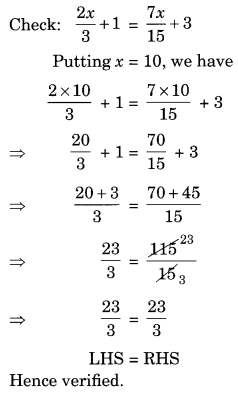
Ex 2.3 Class 8 Maths Question 9.
2y +
Solution: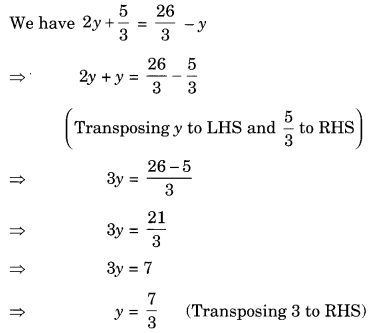
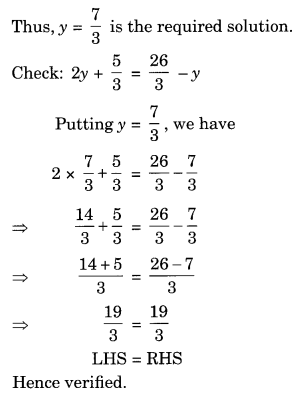
Ex 2.3 Class 8 Maths Question 10.
3m = 5m –
Solution:
We have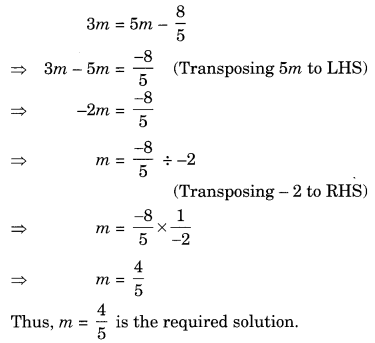
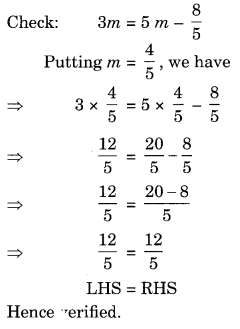
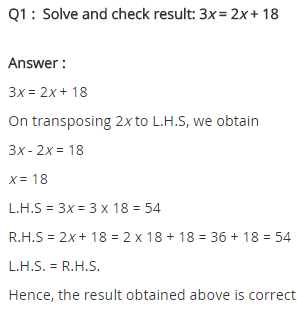
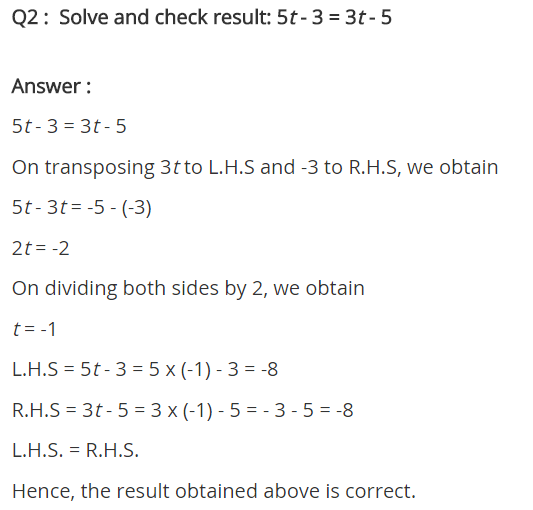
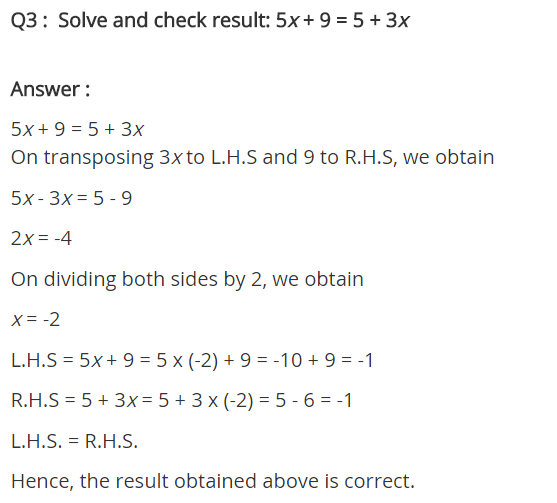
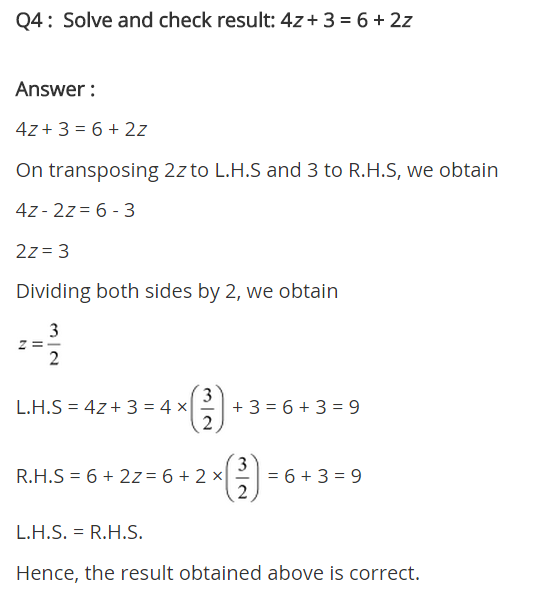
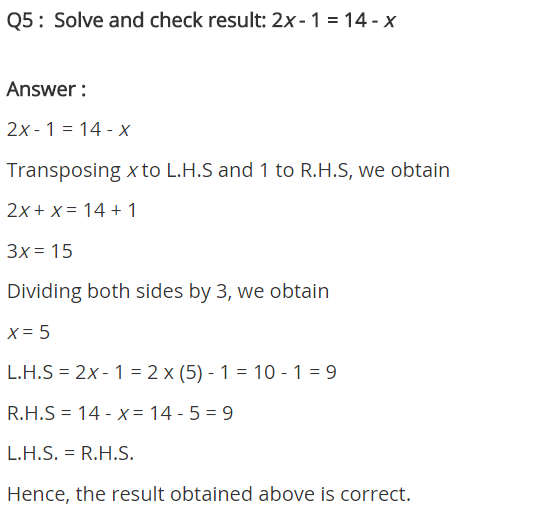
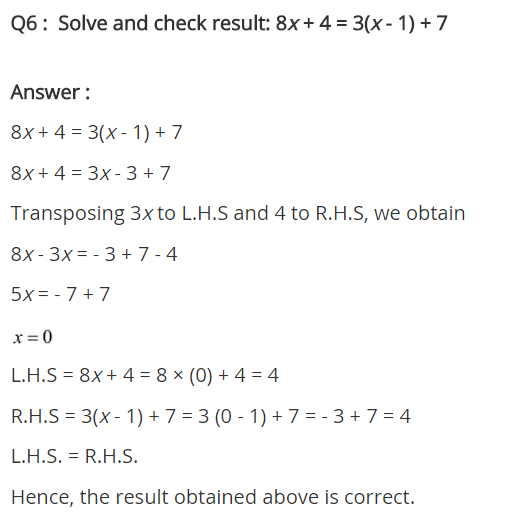
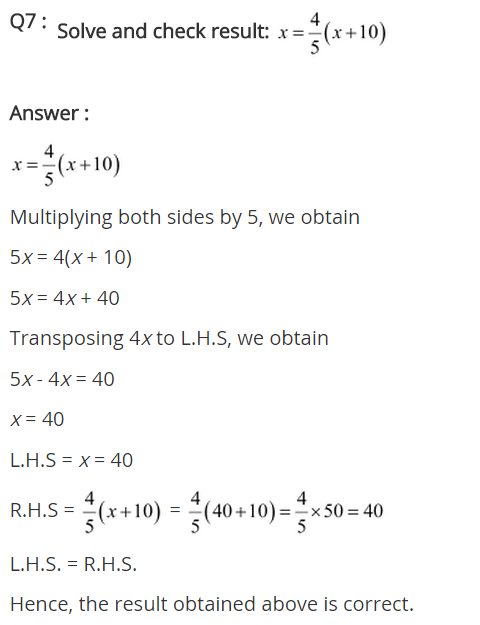
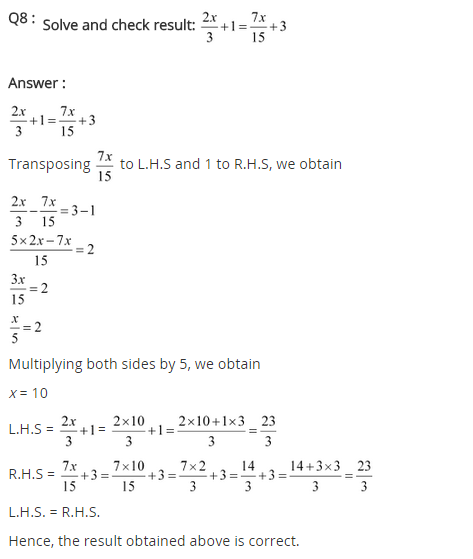
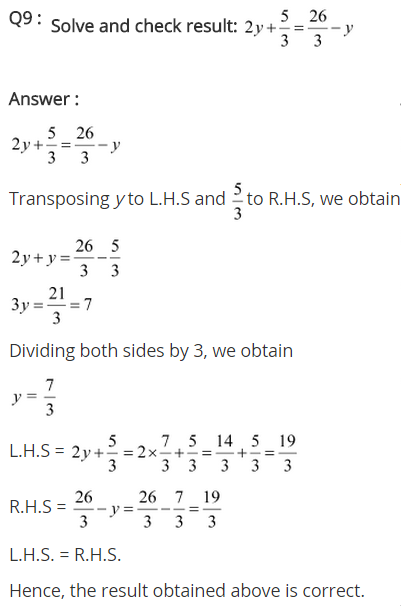
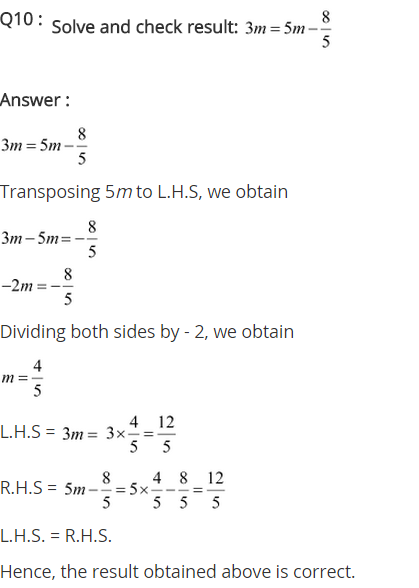
Exercise 2.4
Question 1.
Amina thinks of a number and subtracts
Solution:
Let the required number be x.
Condition I: x –
Condition II: 8 × (x –
Condition III: 8 × (x –
⇒ 8x –
⇒ 8x – 20 = 3x
⇒ 8x – 3x = 20 (Transposing 3x to LHS and 20 to RHS)
⇒ 5x = 20
⇒ x = 20 ÷ 5 = 4 (Transposing 5 to RHS)
Thus, x = 4 is the required number.
Question 2.
A positive number is 5 times another number. If 21 is added to both the numbers, then one of the new numbers becomes twice the other number. What are the numbers?
Solution:
Let the positive number be x.
Other number = 5x
Condition I: x + 21 and 5x + 21
Condition II: 5x + 21 = 2 (x + 21)
⇒ 5x + 21 = 2x + 42 (Solving the bracket)
⇒ 5x – 2x = 42 – 21 (Transposing 2x to LHS and 21 to RHS)
⇒ 3x = 21
⇒ x = 21 ÷ 3 = 7 (Transposing 3 to RHS)
Thus, the required numbers are 7 and 7 × 5 = 35.
Question 3.
Sum of the digits of a two digit number is 9. When we interchange the digits, it is found that the resulting new number is greater than the original number by 27. What is the two-digit number?
Solution:
Let unit place digit be x.
Ten’s place digit = 9 – x
Original number = x + 10(9 – x)
Condition I: 10x + (9 – x) (Interchanging the digits)
Condition II: New number = original number + 27
⇒ 10x + (9 – x) = x + 10(9 – x) + 27
⇒ 10x + 9 – x = x + 90 – 10x + 27 (solving the brackets)
⇒ 9x + 9 = -9x + 117 (Transposing 9x to LHS and 9 to RHS)
⇒ 9x + 9x = 117 – 9
⇒ 18x = 108
⇒ x = 108 ÷ 18 (Transposing 18 to RHS)
⇒ x = 6
Unit place digit = 6
Ten’s place digit = 9 – 6 = 3
Thus, the required number = 6 + 3 × 10 = 6 + 30 = 36
Question 4.
One of the two digits of a two digit number is three times the other digit. If you interchange the digits of this two-digit number and add the resulting number to the original number, you get 88. What is the original number?
Solution:
Let unit place digit be x.
Ten’s place digit = 3x
Original number = x + 3x × 10 = x + 30x = 31x
Condition I: 10x + 3x = 13x (interchanging the digits)
Condition II: New number + original number = 88
13x + 31x = 88
⇒ 44x = 88
⇒ x = 88 ÷ 44 (Transposing 44 to RHS)
⇒ x = 2
Thus, the original number = 31x = 31 × 2 = 62
Hence the required number = 62
Question 5.
Shobo’s mother’s present age is six times Shobo’s present age. Shobo’s age five years from now will be one third of his mother’s present age. What are their present ages?
Solution:
Let Shobo’s present age be x years.
Shobo’s mother’s age = 6x years.
After 5 years Shobo’s age will be (x + 5) years.
As per the condition, we have
x + 5 =
⇒ x + 5 = 2x
⇒ 5 = 2x – x (Transposing x to RHS)
⇒ 5 = x
Hence Shobo’s present age = 5 years
and Shobo’s mother’s present age 6x = 6 × 5 = 30 years.
Question 6.
There is a narrow rectangular plot, reserved for a school, in Mahuli village. The length and breadth of the plot are in the ratio 11 : 4. At the rate of ₹ 100 per metre, it will cost the village panchayat ₹ 75000 to fence the plot. What are the dimensions of the plot?
Solution:
Let the length and breadth of the plot be 11x m and 4x m respectively.
Fencing all around = perimeter of the rectangular plot
Perimeter of the plot =
2(l + b) = 750
⇒ 2(11x + 4x) = 750
⇒ 2(15x) = 750
⇒ 30x = 750
⇒ x = 750 ÷ 30 = 25
length = 11 × 25 m = 275 m
and breadth = 4 × 25 m = 100 m
Question 7.
Hasan buys two kinds of cloth materials for school uniforms, shirt material that costs him ₹ 50 per metre and trousers material that costs him ₹ 90 per metre. For every 3 metres of the shirt material, he buys 2 metres of the trouser material. He sells the materials at 12% and 10% profit respectively. His total sale is ₹ 36,600. How much trouser material did he buy?
Solution:
Ratio of shirt material bought to the trouser material bought = 3 : 2
Let the shirt material bought = 3x m
and trouser material bought = 2x m
Cost of shirt material = 50 × 3x = ₹ 150x
Cost of trouser material = 90 × 2x = ₹ 180x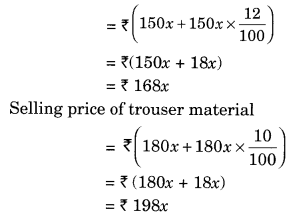
As per the conditions, we have
168x + 198x = 36,600
⇒ 366x = 36,600
⇒ x = 36600 ÷ 366 = 100
Length of trouser material bought = 2 × 100 = 200 m.
Question 8.
Half of a herd of deer are grazing in the field and three-fourths of the remaining are playing nearby. The rest 9 are drinking water from the pond. Find the number of deer in the herd.
Solution:
Let the number of deer be x.
As per the condition, we have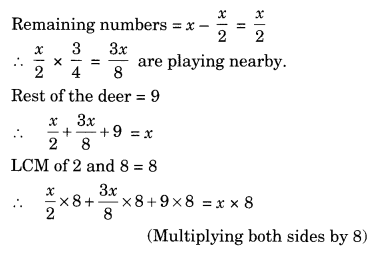
⇒ 4x + 3x + 72 = 8x
⇒ 7x + 72 = 8x
⇒ 72 = 8x – 7x (Transposing 7x to RHS)
⇒ x = 12
Hence, the required number of deer = 72.
Question 9.
A grandfather is ten times older than his granddaughter. He is also 54 years older than her. Find their present ages.
Solution:
Let the present age of granddaughter = x years.
the present age of grandfather = 10x years.
As per the conditions, we have
10x – x = 54
⇒ 9x = 54
⇒ x = 54 ÷ 9 = 6 [Transposing 9 to RHS]
Hence, the present age of the granddaughter = 6 years
and the present age of grandfather = 6 × 10 = 60 years.
Question 10.
Aman’s age is three times his son’s age. Ten years ago he was five times his son’s age. Find their present ages.
Solution:
Let the present age of the son be x years.
Present age of Aman = 3x years
10 years ago, the son’s age was = (x – 10) years
10 years ago, the father’s age was = (3x – 10) years
As per the conditions, we have
5(x – 10) = 3x – 10
⇒ 5x – 50 = 3x – 10
⇒ 5x – 3x = 50 – 10(Transposing 3x to LHS and 50 to RHS)
⇒ 2x = 40
⇒ x = 40 ÷ 2 = 20
Hence, the son’s age = 20 years.
and the age of Aman = 20 × 3 = 60 years.
Exercise 2.6
Solve the following equations.
1. (8x – 3)/3x = 2
Solution:
(8x – 3)/3x = 2
⇒ 8x/3x – 3/3x = 2
⇒ 8/3 – 1/x = 2
⇒ 8/3 – 2 = 1/x
⇒ (8 – 6)/3 = 1/x
⇒ 2/3 = 1/x
⇒ x = 3/2
2. 9x/(7 – 6x) = 15
Solution:
9x/(7 – 6x) = 15
⇒ 9x = 15(7 – 6x)
⇒ 9x = 105 – 90x
⇒ 9x + 90x = 105
⇒ 99x = 105
⇒ x = 105/99 = 35/33
3. z/(z + 15) = 4/9
Solution:
z/(z + 15) = 4/9
⇒ z = 4/9 (z + 15)
⇒ 9z = 4(z + 15)
⇒ 9z = 4z + 60
⇒ 9z – 4z = 60
⇒ 5z = 60
⇒ z = 12
4. (3y + 4)/(2 – 6y) = -2/5
Solution:
(3y + 4)/(2 – 6y) = -2/5
⇒ 3y + 4 = -2/5 (2 – 6y)
⇒ 5(3y + 4) = -2(2 – 6y)
⇒ 15y + 20 = -4 + 12y
⇒ 15y – 12y = -4 – 20
⇒ 3y = -24
⇒ y = -8
5. (7y + 4)/(y + 2) = -4/3
Solution:
(7y + 4)/(y + 2) = -4/3
⇒ 7y + 4 = -4/3 (y + 2)
⇒ 3(7y + 4) = -4(y + 2)
⇒ 21y + 12 = -4y – 8
⇒ 21y + 4y = -8 – 12
⇒ 25y = -20
⇒ y = -20/25 = -4/5
6. The ages of Hari and Harry are in the ratio 5:7. Four years from now the ratio of their ages will be 3:4. Find their present ages.
Solution:
Let the age of Hari be 5x and Harry be 7x. 4 years later,
Age of Hari = 5x + 4 Age of Harry = 7x + 4
According to the question,
(5x + 4)/(7x + 4) = ¾
⇒ 4(5x + 4) = 3(7x + 4)
⇒ 20x + 16 = 21x + 12
⇒ 21x – 20x = 16 – 12
⇒ x = 4
Hari age = 5x = 5 × 4 = 20 years
Harry age = 7x = 7 × 4 = 28 years
7. The denominator of a rational number is greater than its numerator by 8. If the numerator is increased by 17 and the denominator is decreased by 1, the number obtained is 3/2. Find the rational number.
Solution:
Let the numerator be x then denominator will be (x + 8)
According to the question,
(x + 17)/(x + 8 – 1) = 3/2
⇒ (x + 17)/(x + 7) = 3/2
⇒ 2(x + 17) = 3(x + 7)
⇒ 2x + 34 = 3x + 21
⇒ 34 – 21 = 3x – 2x
⇒ 13 = x
The rational number is x/(x + 8) = 13/21





